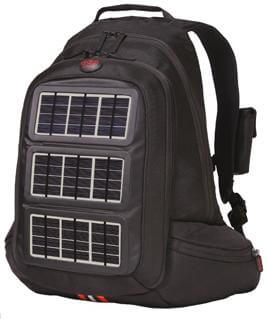
Every time my mobile phone battery dies while I’m on the go, it takes a little part of me with it. Thankfully I can get that lost chunk of soul back with the power of the sun. The last few years have seen the rise of the solar backpack – a typical carrying case with solar panels sewn on its exterior. Place a solar bag in sunlight and you’ll be able to charge your cell phone or other small electronic device in a few hours. Just in time for night school. Check out the six different options we found for plugging your mobile into the sun. Eco-geek-chic never looked so good.
We all know that the sun is the most abundant renewable energy resource we have on the planet, with tens of thousands of tetrawatts headed our way as you read this. Even with all that juice, charging your mobile devices on the go can take hours of sunlight. As you look for the perfect solar bag, keep in mind that the power outputs quoted are maximums, and usually depend on bright days in areas with strongly reflective surfaces nearby (water, snow, glass).
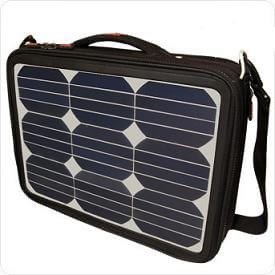
Let’s start with one of the biggest names in the business, Voltaic Systems. They have an entire line of solar bags and accessories that can get you converting a warm nap in the sun into meaningful work. The flagship of their bags is the Generator, the only pack we’ve seen with enough juice to charge a laptop. The Generator puts out up to 15 watts, comes with a battery to store power, and is even made from recycled PET plastic. It’s 20% efficiency solar cells will charge most laptops in five hours. No wonder then that it retails for $500 and is sold out all the time. Buying the solar panels alone would still cost you $200. For that price you may want to look to Voltaics other bags which start around $200, typically put out 4.5 watts, come with a battery, but won’t charge laptops. At that power they will charge most mobile phones in 2 hours or so. Voltaic sells a wide range of adapters to convert from the battery to the device, most are just $3-4.
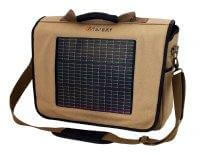
Say you want things cheaper, you can check out Eclipse Solar Gear, which has bags starting around $160. Depending on the model they’ll put out 2.5 to 4 watts which is enough to charge your phone. They don’t have batteries and only come with a 12 volt outlet – you’ll need your own car cigarette lighter-style adapter. Still, they’re stylish looking and are probably the cheapest solar bags you’ll be able to find. Batteries retail for $60 and are on sale for around $30.
If you want some even better style, check out Sakku from Switzerland. Their bags start around $250 and range in power outputs from 2.5 to 5 watts. At that rate, they estimate they can charge most phones in a few hours, though they quote up to 9 hours for some devices. Actually, that last estimate may be the most honest of the ones we’ve seen so far. None of these companies directly comes out and warns you that bags will be less useful depending on time of year and day, but Sakku’s 9 hour quote is close.
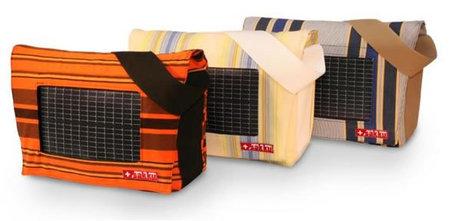
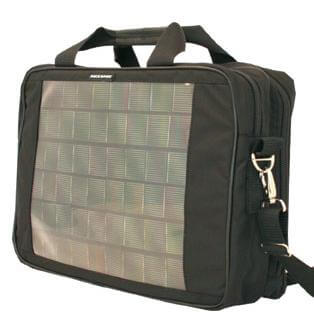
Juice Bags from Reware look like the same hardware ported over to half a dozen different forms. Every Juice Bag (the name is growing on me) puts out 6.3 watts and comes with a standard 12 volt output. Adapters sell for around $9. The bags themselves start around $200 and go up quickly depending on the size and shape. Recycled plastic and cotton (as well as other post-consumer materials) are used almost exclusively, hence Reware’s name, and give the line of bags some extra eco-cred. Watch out though, batteries are not included, and it’s unclear how much they’ll set you back.
TimBuk2 has been helping promote the Flex Light And Power (FLAP) bag, part of the Portable Light Project. The FLAP bag is a 2 or 4 watt carry-all that comes with a powerful twist: the charging panels easily pop out. Yep, the flap of the FLAP bag is a quick way to adapt your solar charging to new situations. In fact, FLAP bags were sent to Haiti to help with relief efforts after the recent earthquake,. These bags have been popping up in non-profit endeavors all over the world, but getting your hands on a retail version is difficult. If you want to purchase 200 units or more, you can just fill out a form. Otherwise, talk to your local store. Here’s a quick video showing FLAP’s versatility, and another video showing how it could help provide portable power in developing nations.
If buying a eco-friendly socially conscious solar powered bag just seems too mainstream for you, you can always build your own. That’s what Jon Kalish did and he’s put up the instructions for you to follow in his footsteps on the National Public Radio site. You can listen to the full story here.. All in all, Kalish’s bag cost around $40, not including labor, and not including a battery. Such an addition is likely to add another $25 or more to the costs of the bag. Also, the do-it-yourself bag he made only puts out a maximum of 0.6 watts. Yikes, that’s going to take a while to charge a phone. You’d probably want to double or triple his solar panel area (or get higher efficiency cells) and that’s going to raise the price. The real costs of a competitive DIY bag might be closer to $120. Still, the financial rewards aren’t nearly as important as the sense of accomplishment you’ll feel whenever you point to your hand crafted bag and say “I’ve conquered the sun.”
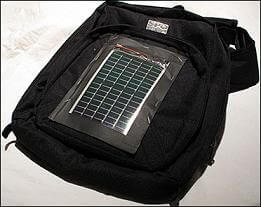
Whether you’re spending green to stay green or building your own solar paneled pouch, you’ve got plenty of opportunity to convert sunlight into more time on your favorite gadgets. Which is a good excuse for me to spend some more time lounging in the summer sun. If you’ll excuse me, my backpack and I need to work on our tans.
[image credits: Voltaic Systems, Eclipse Solar Gear, Sakku, Reware, TimBuk2, NPR/Dick Demenus]
[media credits: Flap Project, Mark Lucach , NPR]
[sources: Voltaic, Eclipse, Sakku, Reware, TimBuk2, NPR]



